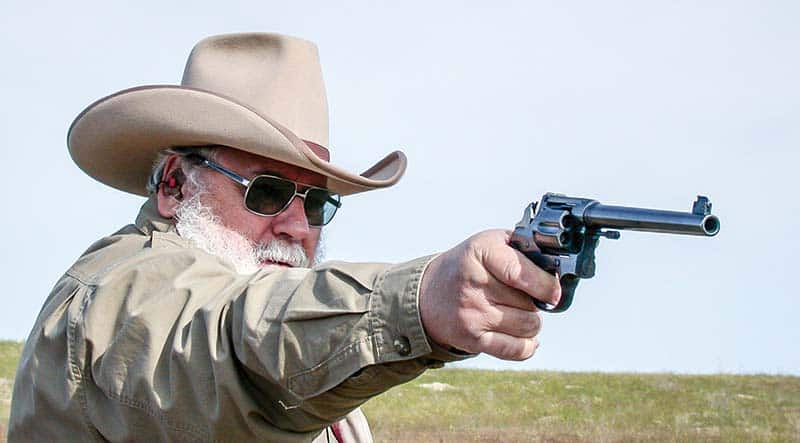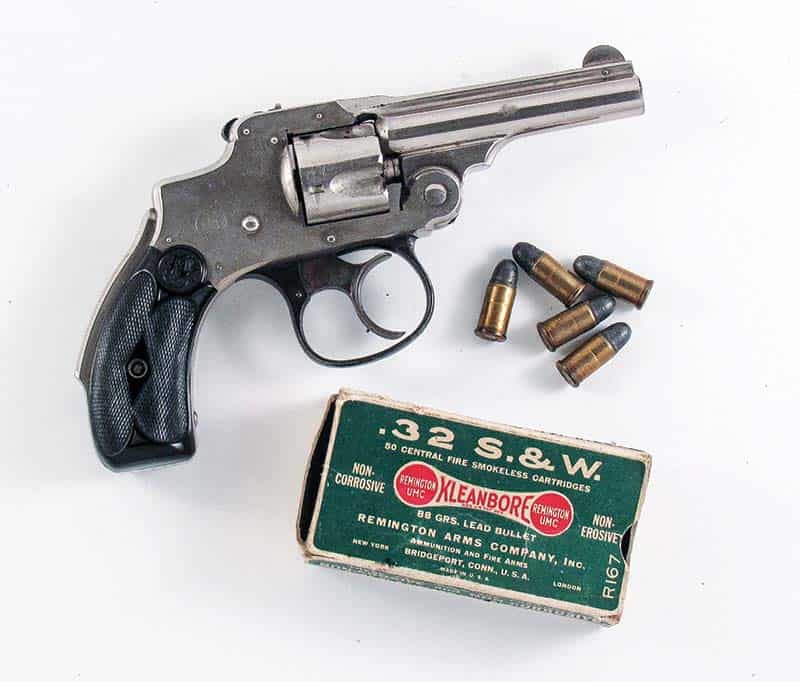Voices From The Past: Part 2
The Double-Action Revolver
Last month we looked at thoughts on semi-auto pistols made five generations ago or so. Now as we turn to double-action revolvers we need to set the stage. The .38 S&W Military & Police had been around for about five years and I find it somewhat amazing this relatively new cartridge and sixgun were held in such high esteem (as was the Colt version). The big-bore Colt New Service was also available by this time, but most shooters opted for the smaller framed .38 Specials from S&W and Colt. Again, remember these comments — culled from the pages of Outdoor Recreation magazine — date back to 1906!
“I have a few words to say in regard to the .38 Special. I am the happy owner of a .38 Military Model Smith & Wesson revolver with a 5″ barrel, and I have yet to see a revolver that will excel it in accuracy or penetration. I have several times shot it through the 4″ side of a 2×4 post and I do not know where it went after passing through this. A pistol that will go through 4″ of our Georgia pine I believe will meet the requirements of what a pistol is used for.”
Apparently this shooter sees the only use for a pistol is up close for self-defense:
“Now there are few improvements that can be made on the Smith & Wesson Military Model .38 Special. Make it with the old Army Model Colt grip, single action, with less sweep to the hammer than we have on the old Army model and with by all means an upfront cylinder lock, but please don’t pay any attention what these different pistol cranks are saying in regard to fancy sights. The proper way to shoot a pistol is without any sights.”
Here’s quite a contrast from the previous reader who says the proper way to shoot a revolver is without sights. I think this one is right on the money:
“I feel as if something should be said in defense of the so-called fancy sights. The sights I prefer are known as the Patridge sights. They are preferred by Mr. E.E. Patridge of Boston, MA one of the finest revolver shots in the United States. The work Mr. Patridge has done with them is sufficient to prove their merit as target sights. They are especially adapted to the .38 Smith & Wesson Special and can be obtained from the Smith & Wesson Company. These sights are far ahead of the ordinary factory sight, under all conditions, where any kind of a sight is needed. Now, with regard to the fear, expressed by some that target sights would be knocked out of alignment by carrying your revolver on the hip or by other rough situations, I can say, safely, they will stand as much abuse as the factory sights.”
I find this very interesting since it not only recommends the .38 Special Smith & Wesson for big game hunting but it also recommends being able to shoot the loads very quickly up close:
“I have used many kinds and makes of revolvers, from the old muzzleloader up to the 1905 Model Smith & Wesson .38 Special military revolver, one which I hold in my experienced point of view is the very elite of revolvers. I have shot it many times in all kinds of weather and at all kinds of things and never found it asleep (so to speak). It is the finest all-around arm for either target or hunting larger small game. I can shoot with it just as well as with a rifle, and for game up to deer I much prefer it. I like a single action revolver for common, everyday hunting and target shooting, for the trigger pull is much softer and one is not so apt to pull the sights off. But there comes a time in most big-game hunters’ lives when they have to pump them in again at short range or never see home again. Then I say the double-action is just the thing.”
Not too many of today’s handgunners would agree with this writer’s claim the .38 Special kills as well as a big bore:
“I have three revolvers — one .38 Colt Double Action, one .38 Colt Single Action, 1871 Model and a .32 Colt New Police. For target practice I like the old SA 7-1/2″ barrel the best. But for toting round the Double-Action .38 is my gun. For game, from wild goats to cattle, it can’t be beat, I use the S&W Special cartridge and gun and find it kills as well as a .44 or a .45. But for smaller game it is no good. I shot a quail the other day and had some skin and feathers left — the bullet took the rest.”
Here we have a vote for something other than the .38 Special, but with certain barrel length stipulations:
“If I expected to pack a heavy revolver, a .44 over .45, I would pick a model with its barrel under 6″ in length. Very long barrels are either not convenient or fast on these guns. The only place I would consider using a 7-1/2″ barrel would be at target shooting where the drawing and firing is deliberate, when time is no object. A Colt New Service .45, for instance, with a 7-1/2″ barrel, is quite clumsy even when carried in the big Mexican holster. The 5-1/2″ length handles so much easier I would buy nothing longer on a big bore handgun.”
Then we have a reader who goes the opposite direction and prefers a smaller caliber:
“The .32-20 is above the class of the common .32 S&W and .32 autos. It has as much shocking power as the .38 Special, although its ballistic energy and foot-pounds does not figure as large. Its velocity is high for a revolver and still it carries up substantial weight of lead. Colt makes a good .32-20 model which with a 4″ barrel weighs but 22 oz., and has a total length of only 8-1/2″. This length is about the limit for convenient pocket guns. I do not care to try and get anything longer in my pocket. Longer guns call for a belt holster.”
There is a lot of discussion today on what makes the best pocket pistol. In the first decade of the 1900s there wasn’t much choice:
“Smith & Wesson offers a splendid pocket weapon in the Safety Hammerless model shooting the .38 New Police load. This is a gun that has always enjoyed a heavy sale in spite of the fact we seldom ever see it mentioned in print. Without any hesitation I am glad to give it preference as the best strictly pocket revolver we have for self-defense purposes. The .38 New Police load is not perhaps ideal from the point of stopping power, but it is much superior to the .32 revolver loads and the .380 autos. This is not a target gun or a target load, but still some fair groups can be fired with it after some practice. You must accustom yourself to take up the slack in the trigger and force the cylinder around and firing the same and then let the hammer off with a final squeeze. Double-action guns can be fired almost as fast as automatics. Incidentally the Safety Hammerless was the first gun produced with the grip safety.”
Another vote for the Safety Hammerless:
“First in our list for a pocket self-defense guns stands the .38 S&W Safety Hammerless with 3-1/4″ barrel. Next in line I would place the Colt 4″ .32-20 Police Positive Special.”
Here is a fellow who really likes .32s and today would probably be highly in favor of the .32 Magnum and .327 Magnum:
“My recommendation for a small game belt gun to be used in big-game country where small game is easier killed than it is in a strictly small game country, is either a Colt or a Smith & Wesson with a 6″ barrel and target sights, chambered to shoot the .32 S&W Long cartridge. Here is a load that shoots very easily without recoil and undue noise and it will kill any small game. The trapper feels justified in using a hand gun and it is pretty accurate — a number of target shooting enthusiasts to the contrary.”








